Nowadays, the need for fast, reliable, and efficient delivery services is on the rise. Online shopping is booming, and customers are expecting quicker delivery service. Therefore, many businesses are turning towards technology in order to fulfil these demands, and courier delivery apps have come into our lives as one of the best ways to do so.
Courier delivery applications are transforming how businesses work with logistics to provide an easy process both for customers and courier drivers. However, the development of a courier delivery application isn't a matter of simple discussion. Instead, it takes careful planning and the use of the right technology along with user-friendly designs to fulfill the requirements both for the users and for the business.
Are you planning to develop a courier delivery app? Then, this courier delivery app development guide is for you. We’ll talk about everything that you need to know.
Market Statistics of Courier Delivery App
If you want to make a courier delivery app, you should know the market statistics as it will help to understand the market. The courier delivery app market has experienced significant growth in the past years. Below are some key statistics and trends that highlight the market's current state.
-
The courier services market size is expected to grow in the next few years. It will grow to $602.47 billion in 2028 at a compound annual growth rate (CAGR) of 6.6%.
-
The global courier, express, and parcel (CEP) market was valued at $407.7 billion in 2021, and is expected to reach $749 billion by 2031. It is growing at a CAGR of 6.3% from 2022 to 2031.
-
The global medical courier market size was valued at $9277.34 million in 2022 and it is expected to reach $16237.27 million by 2032, registering a CAGR of 6.42% from 2023 to 2032.
-
Courier apps offer bulk shipping and specialized services like scheduled deliveries. International shipping is gaining popularity, particularly with the rise of subscription-based e-commerce models.
-
Courier delivery apps are integrated with real-time GPS tracking and AI-based route optimization technologies are significantly reducing delivery times and costs. This has helped courier services in smooth operations while maintaining customer satisfaction.
What is a Courier Delivery App?
A courier delivery app is a mobile application that allows users to send and receive packages quickly. It connects customers with couriers who pick up and deliver items to specified locations. These apps provide various features for the customers like- real-time tracking, payment options, and delivery time estimates.
They are commonly used for local or same-day deliveries. It provides an efficient and convenient way for businesses and individuals to send goods.
Types of Courier Delivery Apps
When intending to create a courier delivery app, it is crucial to recognize that various types of courier delivery applications exist in the market, including on-demand delivery apps, scheduled delivery apps, business courier apps, and peer-to-peer delivery apps, among others. Therefore, let’s look into each one in detail.
A] Uses for On-demand delivery
Through on-demand delivery applications, packages can arrive at any moment. Customers can get items typically within hours or on the same day.
Users can monitor their delivery instantly and keep an eye on the courier's location as they head to the destination. For instance, Uber Eats, DoorDash, Postmates, and so forth.
B] Scheduled Delivery Applications
Scheduled delivery applications enable users to arrange deliveries for a designated future time. These applications offer the ability to schedule deliveries ahead of time. It is a scheduling method based on time, allowing users to select the precise date and time for delivery, thus providing them greater control over when packages are received or collected.
It enables customers to choose a time that suits their availability. For instance, Lalamove, GoJek, and Deliv, among others.
C] Business Courier Applications
Business courier applications are designed for companies. Business courier applications typically offer advanced functionalities and solutions for large-scale shipping, live tracking, and integration with inventory management systems.
Typically, these applications are incorporated into the e-commerce platform. Paraphrase: ShipBob, Sendle, EasyPost, ShipStation, and similar services.
D] Courier Apps for Peer-to-Peer
Peer-to-peer (P2P) delivery applications connect individuals who need items transported with nearby couriers. Through these applications, users can function as both senders.
P2P delivery apps empower everyday people to make deliveries, sometimes on a part-time or freelance basis, providing an efficient and cost-effective solution for local deliveries. For example- Roadie, GoShare, Piggyback etc.
After taking inspiration about the types of courier delivery apps, you can build a courier delivery app of your choice. It will help you to grow your business.
Understanding How Courier Delivery App Works?
Before understanding how to develop a courier delivery app, you should understand how these apps work. These apps connect customers with drivers who deliver parcels, documents, food, groceries, and whatever the customers order for themselves. It offers faster and often more affordable alternatives to traditional courier services. Let's discuss the apps in detail.
1. Sign Up Process
The process of developing a courier delivery app begins when senders and delivery partners sign up and create their profiles. Senders can be individuals or business persons who need items delivered. They provide basic information such as name, contact details, and payment information.
On the other side, couriers are the individuals or drivers who deliver packages. They also register and provide details like their location, vehicle type, and other necessary information. They may be independent contractors or employees of a delivery service company.
2. Delivery Request
The next step is placing a delivery request by the users on the app. In this stage, pickup and drop-off details are provided to the customers. It includes- pickup address, drop-off address, package size, and delivery time preference.
The sender can choose from different delivery types, like- standard delivery which might take a few hours or up to a day, same-day delivery which is for urgent deliveries that need to be completed on the same day, and scheduled delivery where the sender wants to schedule the delivery at a specific date and time.
3. Acceptance of the Order
After placing an order acceptance of the order is one of the most important parts. The courier has the option to accept or decline the job based on their availability. If the courier accepts the job, they proceed to pick up the package from the sender’s location.
4. Real-Time Tracking
Once the courier picks up the package, real-time tracking starts. Through this process, both the sender and the recipient can track the delivery progress via the app. They can see the courier’s route, estimated delivery time, and any changes in real-time.
5. Delivery Confirmation
The final process of understanding how the courier apps work ends with the process of delivery and confirmation of the delivery. If the sender has requested a signature upon delivery, the recipient signs directly on the app’s interface. It ensures the trust in the application.
List of Some of the Best Courier Delivery Apps
There are various types of courier delivery apps on the market. If you want to know how to create a courier delivery app, you should first research the market and study some of the best courier delivery apps to ensure a smooth-running app.
|
Name of the Apps |
Key Features |
Dunzo |
The Dunzo app provides real-time tracking features with the app and ensures integration with the secure payment system. |
Wefast |
Wefast courier service Handles your packages carefully and ensures timely deliveries. |
Pidge |
Pidge delivery service provides instant delivery of the items and allows customers to track parcels until the item reaches their destination. |
Swiggy Genie |
Swiggy Genie courier delivery app provides on-demand services and ensures secure delivery of several items. |
Saral |
Saral is an amazing courier delivery service that allows customers to deliver items on same-day, intra-city. |
Blue Dart |
Blue Dart app provides time-based, slot-based services, cash-on delivery options, automatic proof of delivery services etc. |
Why You Should Invest in Courier Delivery App Development in 2025
If you want to create an on-demand courier delivery app, you should invest in it as it can bring new opportunities due to the rapid growth of this industry. Here are some core reasons why you should invest in the courier delivery app.
► Increasing Demand for On-Demand Deliveries
With the increasing demand for on-demand services and online shopping, many consumers today would like to have fast delivery options that are reliable. Courier delivery apps can simply meet these demands with real-time tracking, flexible schedules, and immediate service.
► Increased Consumer Demand and Expectations
Consumers are now accustomed to fast, reliable, and convenient services. Apps that provide features such as same-day delivery, secure payments, and real-time updates are highly valued, making them a key competitive advantage in the market.
► Technological Advancements
With the technological advancements, the demand for the app is increasing. User-friendly features like- GPS and route optimization algorithms are improving delivery efficiency. By investing in app development, you can improve your business by providing faster, cost-effective, and more reliable delivery services.
► Global Expansion Opportunities
As consumers seek quicker and more affordable delivery options, courier delivery apps can easily scale globally. The flexibility to operate in various regions and the ability to integrate with local courier services make it an ideal business for international expansion.
► High Return on Investment
The courier delivery market can offer you a high return on your investment. You can capture a significant share of this rapidly growing market by investing in courier app development and, thus, potentially achieve a high return on investment.
Core Courier Delivery App Features, You Can't-Miss
In this courier delivery app development guide, we will discuss some user-friendly features that the app offers to their customers. All the features help to boost the industry. Let's discuss some core features of the courier delivery app.
A] Real-time tracking
One of the most important features of a courier delivery app is real-time tracking. That is to say, one can trace both the package and its sender and the recipient. The sender can monitor when the package is collected, its route, and estimated delivery time.
The recipient can track the package in real-time, ensuring transparency and reducing anxiety about delivery times and couriers may get to know the optimal routes, thus delivering at faster rates. It ensures transparency, builds trust and reduces customer anxiety about the delivery process.
B] User-Friendly Interface
A clean and easy-to-navigate user interface (UI) is necessary for both senders and couriers. The app should be simple to use, allowing users to quickly book, track, and pay for their deliveries without any technical issues.
A smooth process for sending packages, including options for pickup and delivery details. Automated updates via SMS or push notifications to keep users informed about their package status. This feature improves customer satisfaction and reduces app defection.
C] Multi-Payment Options
Courier delivery apps offer a variety of payment methods to match different customer preferences like Credit/Debit Cards with essential details such as the card number, expiry date, and card security code for safe and easy card payments, digital wallets for integration with services like PayPal, Google Pay, and Apple Pay; cash on delivery for regions where cash transactions are still preferred; and in-app wallets for repeat users.
This feature increases user flexibility and can attract a broader customer base.
D] Geolocation and GPS Integration
Geolocation and GPS functionality are essential for optimizing routes that can ensure accurate deliveries. This feature benefits both couriers and customers.
Route Optimization: The app uses GPS to suggest the fastest routes for couriers, reducing delivery times and costs.
Pickup & Delivery Locations: Couriers can easily locate pickup and drop-off points, even in large cities or remote areas.
This is an efficient navigation system that reduces delays, ensures timely deliveries, and enhances the overall user experience.
E] In-app chat and Communication
Communication feature helps to build trust for the customers. This allows both senders and recipients to contact the courier in real-time which can resolve issues quickly and improve satisfaction.
Real-Time Chat: This system enables senders, recipients, and couriers to communicate within the app, avoiding miscommunication.
Call Integration: Call integration option to call the courier or the customer support team directly from the app.
Push Notifications: It keeps users informed about delivery statuses, updates, or delays.
In-app communication helps resolve issues quickly, builds trust, and keeps the process transparent.
F] Rating and Feedback System
A rating system that allows users to leave feedback about their experience is critical for maintaining high service quality.
Courier Rating: Senders and recipients can rate their couriers based on their experience (timeliness, professionalism, etc.).
Customer Feedback: Couriers can also rate customers, ensuring mutual respect and accountability.
Improvement Methods: Feedback can help the app identify areas for improvement and boost the overall service quality.
This ratings and reviews system ensures service accountability and helps in continuous improvement.
Step-by-Step Guide to Develop a Courier Delivery App
Nowadays, courier delivery apps have become an important service for many customers. So, you can grow your business by developing a courier delivery app. Here is a step-by-step guide to courier delivery app development.
Step 1: Market Research and Analysis
Through market research, you can identify your target audience. Target audience helps to understand who your customers like- individuals or business persons. This step helps to study existing courier delivery apps like Dunzo, Wefast, etc. to identify their strengths and weaknesses.
It helps you research the regulations related to courier delivery, including taxes, insurance, and delivery laws in your region. An on-demand app development company can assist you with market research.
Step 2: Choose a Platform and Tech Stack
The next step after market research is choosing a platform and the right technology stack. If you are deciding to build the app for iOS, Android, or both. You may go for cross-platform development for cost efficiency. To complete this process smoothly, you can hire app developers to develop a courier delivery app.
Tech Stack is another important part where it helps to Choose the programming languages and tools for both frontend and backend development.
Frontend: React Native or Flutter for cross-platform apps; Swift for iOS, Kotlin for Android.
Backend: Node.js, Ruby on Rails, Django for the server-side development.
Database: MySQL, MongoDB for data storage.
Payment Integration: Stripe, PayPal, or other secure payment gateways.
Maps & Location Services: Google Maps API, Mapbox for real-time tracking and route optimization.
Many app development companies offer such tech stacks through their Android app development services and iOS app development services.
Step 3: Design the User Interface (UI) and User Experience (UX)
User interface and user experience are some of the most important parts of developing an app.
You can create wireframes for the user app, courier app, and admin panel. This will serve as a blueprint for the design. User Flow ensures the app has an intuitive flow from registration to order placement, payment, and tracking.
On the other hand, UI Design focuses on simplicity, ensuring the design is clean and user-friendly and UX design ensures the app is responsive, fast, and easy to navigate.
Step 4: Testing
After developing an app, the testing process of the app is one of the key processes. Without testing an app, you can't understand the features and issues of the app. Testing an app includes-
"Unit Testing" where you should test individual components for functionality.
"Integration Testing" which ensures the entire system works as expected when all components are connected.
"User Testing" conducts beta testing with real users to gather feedback and identify potential issues.
"Bug Fixing" which resolves any bugs and improves performance based on feedback from testers.
Step 5: Launch the App
If you have completed the testing process of your app, the final step of this process is launching the courier app for the audience. You can submit your app for review to the respective app stores like- Google Play and Apple App Store.
You can plan for marketing strategy to promote your app. This could include social media campaigns, influencer marketing, and online ads. And finally, after launch, you should closely monitor user reviews and feedback to make necessary adjustments.
Developing a courier delivery app is not an easy task. All the steps discussed above play a very crucial part in developing an app. If you really want to know how to make a courier delivery app, you can refer to the complete development process to understand that easily.
Factors that Affect the Cost of the Courier Delivery App
Buying a courier delivery app needs a good amount of budget and this budget depends on many factors. Depending on the factors, it can be said that the cost of the courier delivery app can cost $20,000- $1,20,000. Let's dive into some of the most important factors.
► App Features and Complexity
App features and complexity are some of the most important parts that have the power to increase the price of your app. More features can attract more customers and are important for your development journey. But the more features you include, the development cost will be high.
A simple courier delivery app might only require basic functionalities like user registration, order tracking, and payment processing. However, advanced features such as real-time GPS tracking, route optimization, multi-language support, push notifications, and in-app chat are important to grow the app and can significantly increase the cost.
► Platform Choice (Android, iOS)
The cost of development varies depending on whether the app is built for Android, iOS, or both platforms. However, if you want to reach a broader audience, you can make a courier delivery app by using tools like Flutter or React Native, which can be more cost-effective than building separate native apps for both platforms.
► Design and User Experience (UX/UI)
A simple and minimal design may cost less, but a custom, detailed design with advanced animations, transitions, and user interface (UI) can increase the cost.
A well-designed user experience (UX) is essential for the app's success. A good UX/UI design requires experienced designers. It is often provided by a mobile app development service, which will ensure that the app is intuitive, easy to use, and visually appealing.
► App Development Team Location
The cost of hiring developers varies depending on the geographical location of the development team. For example- developers in the US, Canada, or Western Europe tend to charge higher rates compared to developers in regions like Eastern Europe, India, or Southeast Asia. You should choose an app development team wisely when you are planning to build a courier delivery app.
On the other side, Working with offshore teams can reduce costs but may present challenges such as communication barriers or differences in working hours.
► Integration with Third-Party Services
Like all other apps courier apps require integration with third-party services like payment gateways, maps and location services, and SMS or email notification services. Each of these integrations requires development effort and can incur additional costs, depending on the complexity and the fees charged by third-party service providers.
For example, implementing a live tracking feature through GPS will require API integration at advanced levels.
► App Maintenance and Updates
After launching the app, regular maintenance and updates are a very important part of the smooth run of the app. This includes fixing bugs, updating to meet new OS versions, enhancing security, and adding new features. If your app requires frequent updates or bug fixes, this could increase the long-term costs.
► Testing and Quality Assurance
Thorough testing is essential to ensure the app works smoothly across different devices and platforms. Testing must cover all app functionalities, including payment systems, GPS accuracy, performance under load, and cross-device compatibility. Quality assurance ensures that the app performs optimally before release and continues to do so after updates. High-quality testing can increase the price of the app.
Monetization Methods of Courier Delivery App
The monetization process is one of the important parts of when we are talking about the on-demand courier delivery app development guide. In this guide, you are learning how to build a courier delivery app for your business, but with that, you should also learn what are the monetization methods of the courier delivery app. Let's discuss some monetization methods.
► Subscription Model
One of the most common ways to generate revenue is through a subscription model, where users or businesses pay a regular fee- monthly or annually for using the app. The subscription model offers free deliveries, priority service, or discounted rates.
► In-App Advertising
In-app advertising is another popular monetization method to monetize your app. By showing ads to users while they are using the app, the app owner can earn money. The ads can be banners, pop-ups, or video ads.
► Partnerships with Businesses
Courier delivery apps can also partner with businesses that need regular delivery services, like e-commerce platforms or local stores. The app can offer customized delivery solutions to these businesses in exchange for a fee.
► Commission from Couriers
Courier apps can take a commission from the couriers or delivery agents who complete the orders. The commission can be a percentage of the delivery fee.
Thus, you can monetize your app and gain profit from the courier delivery app. This can help to boost your business in this ever-growing competitive market.
Build an Exclusive Courier Delivery App with JPLoft
Are you looking to create a reliable and efficient courier delivery app? Then, JPLoft can help you as an experienced courier app development company. We specialize in developing custom mobile apps that are designed to meet your business needs.
At JPLoft, our team of experts will work with you every step of the way to bring your courier delivery app to life. Whether you're just starting or looking to upgrade your existing service, we have the experience and knowledge to help you succeed. We understand that every business is unique. That’s why we create apps that are specifically designed to fit your requirements, whether you need features for real-time tracking, payment integration, or a custom admin dashboard.
Build your exclusive courier delivery app with us and take your delivery service to the next level. Let’s bring your vision to life! Contact us today to get started.
Conclusion
Developing a courier delivery app can be a new opportunity that helps your business and offers convenience to both users and businesses. By following a complete guide to courier delivery app development, you can ensure that every aspect of your app, from design and features to functionality and security, is carefully planned and executed.
No matter if you want to start a startup or an established business looking to expand, an app development company can help you build a user-friendly and efficient app. With the right planning, development team, and continuous support, your courier delivery app can be developed. Take the first step today, and bring your courier service idea into your life.
FAQs
A courier delivery app is an application for the mobile device. This application can request, track, and monitor deliveries in real time. Users are connected with couriers or delivery agents; hence, business people and others can send their packages or goods fast and in a hassle-free way.
The cost of developing a courier delivery app depends on many factors like the complexity of the app, whether it's on Android or iOS, its design, features, and location. A simple app may take about $10,000-$30,000 while more advanced ones with added features may take around $50,000-$100,000 or even more.
The development of a courier delivery application would require roughly between 3 to 6 months, depending on the complexity, the number of platforms it was developed on (iOS, Android, or both), and the efficiency of the development team.
Courier delivery apps can also be tailored according to the requirements of the businesses. For example, some specific business account features could include business accounts with a different pricing policy for bulk orders or certain specific delivery time slots, as desired.
Some of the essential features for a courier delivery app are user registration/login, real-time tracking, payment integration, push notifications, rating & reviews, admin dashboard, and GPS & route optimization.





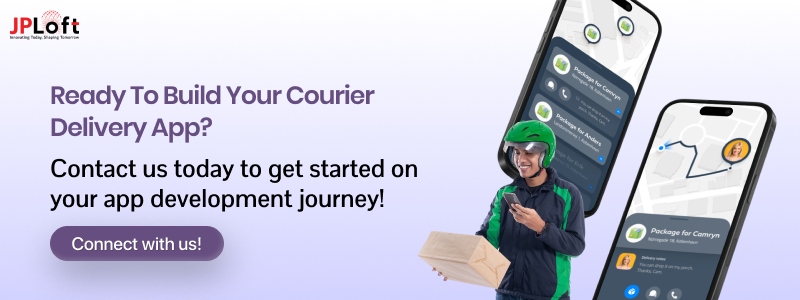
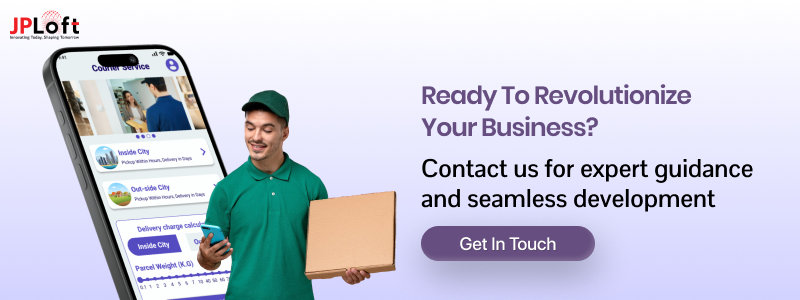

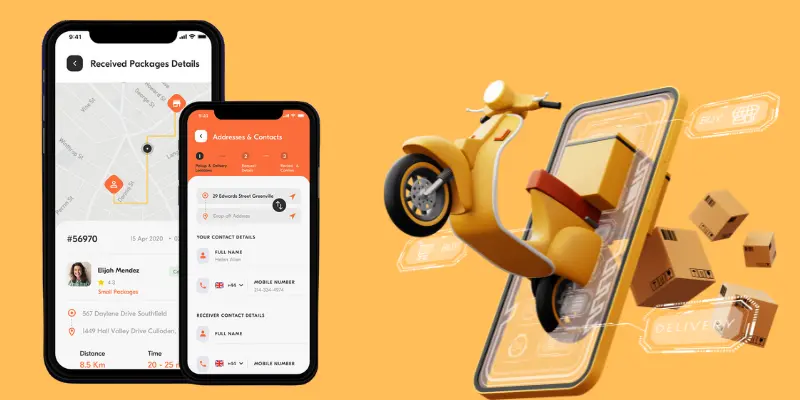
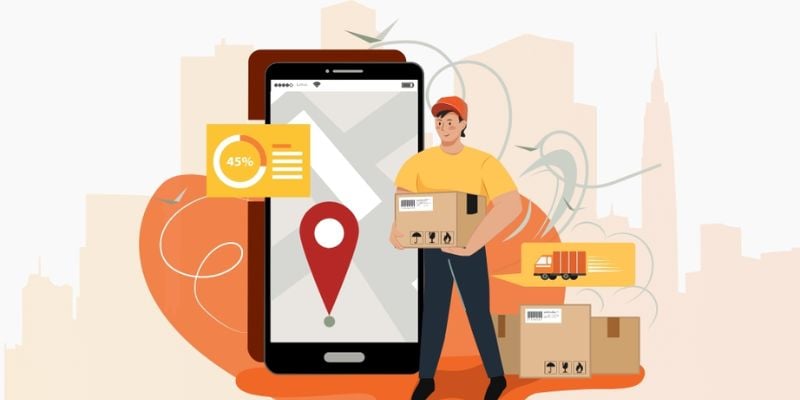
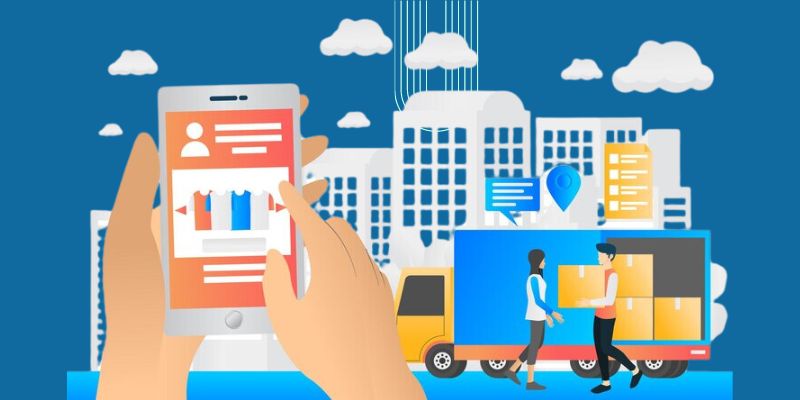


Share this blog